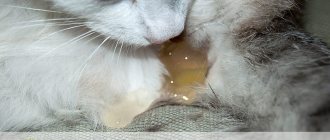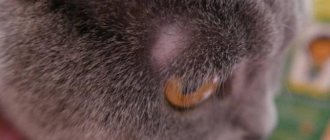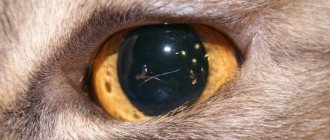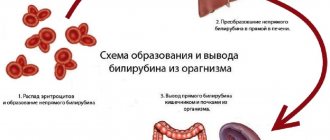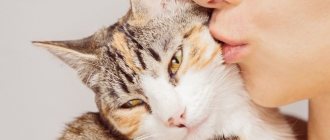What you need to know about white blood cell levels in cats
Let's start with the fact that the normal number of leukocytes is 5.5-18.0 * 109/l. It is ideal if the level remains in this range. Unfortunately, with various diseases it can change significantly. For example, if the white blood cell count is elevated, this is an alarming sign - most likely there is some kind of inflammation in the body. But there is no need to worry right away. The cause may well be a mild cold.
It is much worse if the level is significantly below normal. Then the diagnosis is simple - leukopenia. And this is already very bad. Often this disease is a consequence of sepsis - a serious reaction of the body to an invading infection .
In this case, even the best medicines and high-quality treatment may not save the cat. However, there is no need to sound the alarm prematurely. Sometimes the white blood cell count drops simply because a large number of blood cells die in areas of inflammation. But if a critical decrease in the level of leukocytes in the blood persists not for several days, but for weeks, then the veterinarian will definitely prescribe serious treatment.
Prevention
How to prevent leukopenia? Pet owners and veterinarians advise paying attention to the cat's diet. It must be balanced and enriched with B vitamins. You need to give your cat only high-quality food. Vitamin supplements should be used if necessary.
It is very important to protect your cat from frequent and prolonged stress. The pet must be protected from contact with dogs and aggressive relatives. The animal's independent walks should be minimized or completely eliminated.
If your cat is undergoing corticosteroid therapy, regular blood tests will be required. If there are signs of leukopenia, the dosage of medications must be adjusted.
If the animal has frequent colds, intestinal disorders, or deterioration in the quality of the coat, then the pet must be shown to a veterinarian. This will help identify leukopenia and promptly treat the underlying disease.
source
How to identify the disease
A low level of leukocytes in a cat’s blood can only be detected by the results of clinical tests. And it is advisable to identify any disease as early as possible - often the success of treatment depends on this. Therefore, it is very important to know what signs can be used to detect a decrease in leukocytes. Let's list the main symptoms :
- The animal often suffers from colds. In the most advanced cases, a cat can even catch pneumonia and chronic bronchitis.
- Indigestion that does not stop for a week or more even with a change in food.
- Inflammation of the gums - the cat refuses to eat because it hurts to eat.
- Deterioration of the condition of the coat and skin.
In the most advanced cases, conjunctivitis and bloody vomiting may appear. But this happens relatively rarely.
So, if you notice such signs in your pet, you should visit your veterinarian as soon as possible and get a referral for a complete blood count. The indicators obtained from the formula will allow you to more accurately determine the condition and, accordingly, make a more accurate diagnosis.
Symptoms
If there are low leukocytes in a cat’s blood, this always affects the state of the immune system. The animal begins to get sick often, especially with colds. Complications such as pneumonia and bronchitis often develop.
With leukopenia, your pet often experiences gastrointestinal disorders. Even with proper nutrition and good care, the cat often suffers from vomiting and diarrhea.
The gums and oral cavity become inflamed. Because of this, the animal often refuses to eat. The pet is losing weight quickly. Inflammation of the eyes with purulent discharge appears. At the same time, the cat’s fur loses its shine and looks matted and unkempt. The skin is prone to inflammation.
If the owner discovers such symptoms in his pet, then he needs to take the cat to the veterinarian and do a blood test. It is possible that these phenomena are associated with leukopenia.
Main causes of the disease
As mentioned above, low leukocytes in cats affect the overall decline in immunity. To ensure successful treatment, you must first find out what is causing it.
First of all, this is, surprisingly, stress . If a cat lives in a state of stress for many months and years, this leads to a variety of negative consequences. These include disruption of the bone marrow and, as a result, a decrease in the number of white blood cells produced.
Another possible cause is certain medications. For example, some drugs used to treat arthritis suppress white blood cells, reducing their numbers in the blood. But in most cases the problem can be solved quite easily - just stop taking the medication or switch to another, safer analogue.
Any inflammation causes leukocytes and especially band neutrophils in the blood to drop sharply. Therefore, you need to fight the inflammation itself in order to solve the problem at the root.
But there are also specific diseases due to which leukocytes in the blood are low:
- A range of bacterial infections, ranging from a common abscess to sepsis.
- Pancreatitis – with inflammation of the pancreas gradually leads to leukopenia.
- Bone marrow diseases are the most dangerous option, most often ending in the death of the cat.
Leukopenia in cats - disease prevention
Why can a cat's white blood cells be low? The reasons for such a deviation may be the following:
- Stressful situations. If the animal was frightened on the eve of the study, this may lead to a temporary drop in leukocytes. This is not a dangerous phenomenon. Usually, after the cat calms down, all blood counts return to normal. Prolonged stress can lead to persistent leukopenia. In this case, you need to pay attention to the pet’s lifestyle.
- Avitaminosis. White cell levels may drop if the animal is not fed properly. With a deficiency of B vitamins in food, a decrease in leukocytes gradually develops. However, this situation can be easily corrected. To do this, it is enough to review your cat’s diet and include foods rich in vitamins or special supplements.
- Taking hormonal medications. For arthritis and other joint diseases, cats are prescribed corticosteroids. These drugs quickly relieve pain and inflammation, but at the same time reduce white blood cells. After completing the course of treatment, blood test results return to normal.
In these cases, the leukocytes in the cat’s blood are slightly reduced. This deviation is temporary.
However, leukopenia can also be associated with serious pathologies that require immediate treatment. This may be a sign of the following diseases:
- Bacterial infections. Of these diseases, sepsis is the most dangerous. With this pathology, pathogenic microorganisms constantly circulate in the bloodstream. Panleukopenia (distemper) is also a dangerous infection. With this disease, the level of leukocytes is sharply reduced, as these blood cells are rapidly destroyed.
- Chronic inflammation. Leukocytes rush to the pathological focus and leave the blood.
- Pancreatitis. Inflammation of the pancreas is often accompanied by leukopenia.
- Bone marrow diseases. This is the most dangerous cause of leukopenia. Diseases of the hematopoietic organs are difficult to treat and often result in the death of the pet.
We suggest you read: Hamster sneezes. Why did the hamster start sneezing and what to do?
In any case, low white blood cells in a cat require attention. If this condition is caused by temporary and random reasons, then it is enough to change the animal’s lifestyle and diet. If leukopenia is associated with pathology, then additional examination and treatment by a veterinarian is necessary.
What to do if your cat has low white blood cells? Leukopenia is not a separate disease, it is only a sign that a pathological process is underway in the animal’s body. Therefore, the treatment of this condition will depend entirely on the etiology. The level of white blood cells returns to normal after the cause of leukopenia is eliminated.
It is necessary to treat the underlying disease. If low white blood cells in a cat are associated with infection, then antibiotics and antiviral medications are prescribed. For pancreatitis, following a diet and taking medications to relieve inflammation and normalize pancreatic secretion are indicated.
The most difficult case is leukopenia associated with bone marrow damage. Unfortunately, such diseases have a poor prognosis. Chemotherapy and blood transfusions stop the pathological process, but do not eliminate the disease. Most cats die, even with good treatment.
How to prevent leukopenia? Pet owners and veterinarians advise paying attention to the cat's diet. It must be balanced and enriched with B vitamins. You need to give your cat only high-quality food. Vitamin supplements should be used if necessary.
It is very important to protect your cat from frequent and prolonged stress. The pet must be protected from contact with dogs and aggressive relatives. The animal's independent walks should be minimized or completely eliminated.
If your cat is undergoing corticosteroid therapy, regular blood tests will be required. If there are signs of leukopenia, the dosage of medications must be adjusted.
If the animal has frequent colds, intestinal disorders, or deterioration in the quality of the coat, then the pet must be shown to a veterinarian. This will help identify leukopenia and promptly treat the underlying disease.
Have you been struggling with HYPERTENSION for many years without success?
Head of the Institute: “You will be amazed at how easy it is to cure hypertension by taking it every day...
One of the components of human blood is leukocytes - white blood cells. These cells are part of the immune system, which is why they are called immunocompetent. They are entrusted with the role of protecting the body from various viruses and infections. The number of white blood cells in the blood may increase or decrease.
When their number drops to 4.0x109/l, it is too early to talk about leukopenia (leukocytopenia, neutropenia), but this condition already requires observation. People who have a leukocyte level in their leukocyte formula below 3.7x109/l are subject to examination. It is believed that this is a signal of insufficient production of white blood cells in the bone marrow due to its damage and loss of normal functional abilities.
Often leukopenia occurs without any symptoms at all, and its manifestations depend on the attached infectious agents or on the factors that cause a decrease in leukocytes. However, the first (and often the only) manifestation of this syndrome is an increase in body temperature, accompanied by chills, which is soon supplemented by fatigue, weakness and dizziness that occur for no apparent reason.
At the same time, the heart begins to beat faster and headaches appear. These are the first symptoms of leukopenia. Reduced production of leukocytes leads to decreased immunity. A person begins to suffer from colds and infectious diseases more often, weakening his body. External signs of the disease include enlarged tonsils and swollen glands, exhaustion.
Many people have no idea what the dangers of a sharp decrease in the level of white blood cells in the blood are. They believe that this happens after they have suffered from an illness. This may be so, since many pathological conditions can cause leukopenia. However, it also happens the other way around - many diseases can be caused by leukopenia.
This happens due to a decrease in the body’s defenses when access to various bacterial and viral infections opens. In people with an altered leukocyte formula and a reduced number of leukocytes in the blood, the risk of cancer, viral hepatitis, AIDS and other infections doubles.
For children, this syndrome is dangerous because if the child is not examined and treated, then a serious blood disease - leukemia - can be missed, since its onset can manifest itself as both leukocytosis and leukopenia. Drug therapy (especially cytostatics) can also cause neutropenia in children.
Why does it happen?
Leukopenia, although widespread and well known, still occurs much less frequently than leukocytosis. The etiology and pathogenesis of the syndrome are very extensive. The most common factors that lead to a decrease in the level of leukocytes in the blood are:
- Hereditary diseases that cause various pathologies of hematopoiesis.
- Leukopenia is often caused by an acute deficiency of vitamins B1 and B12, iron, copper and folic acid, which are necessary for the maturation and proliferation of leukocytes. Even dietary errors can lead to this condition.
- Tumors with metastases to the bone marrow, aplastic anemia.
- But the main causes of leukopenia lie in the increased destruction of white blood cells. Most often it is caused by autoimmune processes, potent chemicals that are used in the treatment of cancer and infectious diseases. These include cytostatics, antibacterial agents, and some anti-inflammatory medications. Sometimes medications used to treat epilepsy can cause leukopenia.
- A common cause of decreased formation of all types of blood cells is bone marrow damage (aplasia and hypoplasia) caused by irradiation and increased background radiation.
The most common causes of leukopenia in adults are the destruction and destruction of leukocytes due to increased functioning of the spleen against the background of some difficult-to-treat diseases, such as lymphogranulomatosis, tuberculosis, liver cirrhosis, syphilis, viral hepatitis, etc.
Often, a disease associated with impaired formation of white blood cells is also observed in childhood. For example, transient leukopenia is very often detected in infants. This type of disease is characterized by the fact that the total number of leukocytes in the blood remains normal, and the number of granulocytes (eosinophils, basophils and neutrophils) is reduced to 15% (there are cases of their reduction to 5%).
We suggest you read: Entropion in cats: causes and symptoms
This does not affect the baby's health in any way. There are usually no signs of infection. There are also no abnormalities observed in the bone marrow. The cause of the disease is the mother's antibodies, passed to the baby during intrauterine development. But they are usually quickly washed out, and by the age of four the leukocyte formula returns to normal.
Leukopenia in older children occurs when the number of leukocytes in the blood decreases to a level of 4.0x109/l. The disease manifests itself as a decrease in immunity. The child is often sick. He constantly develops boils, after which, after healing, marks remain on the skin in the form of pockmarks. Almost all children with leukopenia are diagnosed with periodontitis.
As a rule, the child lags behind his peers in growth and does not gain weight well. The causes of the disease are viral infections (measles, rubella, hepatitis), some bacterial diseases (brucellosis or paratyphoid), infections of generalized etiology (sepsis), changes in the hormonal background of the child, and poor heredity.
The cause of the disease is considered to be paroviruses, the DNA of which contains a virus similar to enteritis of dogs and minks. The size of the virus is incredibly small, about 20 nanometers, it looks like a small capsule. It exists in this capsule for about a year at almost any temperature. It feels especially comfortable in organs, animal feces and cells.
Is it possible to cure the disease?
It is impossible to answer this question unequivocally. First you need to find out what caused the drop in nuclear-free formed elements in the blood. Based on this, treatment is prescribed. In some cases, it is generally enough to eliminate the source of stress (ill-mannered children, aggressive dogs, larger and more aggressive cats) or stop taking medications.
In other cases, doctors prescribe polyvalent serums, antivirals and antibiotics.
When bone marrow diseases are detected, even the best treatment can only slightly weaken the disease, delaying the inevitable end.
Unfortunately, if a cat suffers from a disease that poses a danger to humans, it would be better to euthanize it.
Almost everyone knows about the incredible importance of immunity. And for good reason: “miracle remedies” for “strengthening” it are constantly advertised on TV. We will not discuss their real effectiveness, since we are much more interested in those problems that may affect the body’s defense system. For example, leukopenia in cats.
What it is?
This term is used to describe a condition characterized by a significant decrease in the number of white blood cells in the blood. Since white cells are extremely important for the body's immune function, everyone can guess the consequences of this phenomenon.
The normal leukocyte count in cats ranges from 5.5-18.0*109/l. If the indicators are exceeded, then some kind of inflammatory reaction is probably going on in the cat’s body. A low white blood cell count is much worse, since in some cases their number decreases during sepsis. But most often, leukopenia manifests itself only temporarily, against the background of some kind of infectious disease: most of the blood cells die or accumulate in areas of inflammation. The alarm should be sounded in cases where, after observation for several weeks, the number of leukocytes does not rise, remaining at a critically low level.
Clinical manifestations
What are the symptoms of leukopenia in cats? Everything is quite simple here. Firstly, the animal is constantly sick. He is plagued by digestive disorders, and the cat constantly “catch” diseases of the upper respiratory tract. In severe cases, it can lead to chronic bronchitis and even pneumonia. Deterioration of the condition of the skin and coat, as well as inflammation of the gums and other periodontal diseases are often recorded.
In addition, you can notice swollen and inflamed lymph nodes, the animal quickly gets tired, it is lethargic and apathetic. There is no appetite, the cat may experience constant cases of conjunctivitis, bloody diarrhea, vomiting... In short, the symptoms correspond to serious diseases of an infectious and inflammatory nature. It is difficult to say anything specific, since the main clinical sign is a decrease in the number of leukocytes. And this is discovered only during a blood smear examination.
Predisposing factors
Viral infections are the most common cause of leukopenia in cats. Feline immunodeficiency virus (FIV) and feline infectious peritonitis (FIP) are the most dangerous in this regard. Their peculiarity is that infectious agents can penetrate into the leukocytes themselves, where they successfully reproduce and destroy protective cells.
Of course, the number of the latter is sharply decreasing. Other causes of leukopenia may include:
- Bacterial infections. Moreover, this cause refers to almost everything: from abscesses to sepsis.
- Any inflammation causes a decrease in the number of leukocytes (and neutrophils in particular) if it has become chronic.
- All types of bone marrow diseases , including severe injuries, poisoning, exposure to radioactive materials.
- Pancreatitis. Inflammation of the pancreas will “pull” white blood cells from the bloodstream, which over time will lead to leukopenia.
- Certain medications. Corticosteroids, used to treat arthritis and other inflammatory pathologies, suppress the production of white blood cells when used long-term. As a rule, the pathology in this case is reversible.
- Stress. Long-term stress leads to many negative consequences for the body, including disruption of the bone marrow.
Types of leukocytes
If the analysis reveals that the cat’s leukocytes are low, the doctor will prescribe an additional examination. It is called a leukogram. This test helps identify which type of white cells are elevated.
The following types of leukocytes exist:
Let's take a closer look at the possible reasons for the decrease in each of these types of blood cells:
- Lymphocytes are cells that recognize and reject foreign agents. This type of leukocytes can be reduced in chronic diseases of the liver, kidneys and lungs, immunodeficiency states, as well as during treatment with steroid hormones.
- Neutrophils destroy foreign proteins. A decrease in the number of these cells is observed in bacterial and fungal pathologies, anemia and bone marrow diseases. The cause of leukopenia in this case may also be the use of antifungal drugs or radiation therapy.
- Eosinophils fight allergens. A decrease in this type of cells is observed during acute infections, injuries, burns, and also after myocardial infarction. Eosinophilia is also seen in older cats.
- Basophils are rarely detected in the blood of cats. Their presence in the analysis usually indicates an allergy. Therefore, a decrease in basophils or their absence is not a sign of pathology.
- Monocytes reject dying cells and foreign proteins. A decrease in these blood elements can be observed with sepsis, bone marrow damage, as well as after childbirth and during treatment with corticosteroids.
How is this treated?
What is the treatment for leukopenia in cats? Here everything depends on the root cause that caused the decrease in the number of leukocytes in the blood. Antibiotics, antiviral drugs, polyvalent serums are prescribed, operations are performed to excise foci of purulent inflammation, etc.
Unfortunately, bone marrow diseases are incurable, and your pet's life expectancy will depend only on care and supportive therapy. In severe cases, one even has to resort to regular blood transfusions, but in our conditions, for obvious reasons, this is not practiced. If the cat manages to “catch” a disease that is contagious to humans, euthanasia is recommended.
A general blood test of cats, coupled with other types of studies, helps to establish an accurate diagnosis and allows a specialist to determine the severity of the current disease, monitor the dynamics of the disease, adjust the treatment process and predict the outcome of the pathology.
How does infection occur?
When the virus enters the bloodstream, it spreads throughout the body, affecting vital organs and systems.
Routes of infection
Transmission of the disease occurs orally from other animals that are carriers of the pathogen.
The virus can be isolated through urine, saliva, feces and vomit. There have been cases where a pet became infected from fleas.
It is possible that the virus may enter water, food, or get onto a bowl or cat litter. The pet becomes infected and the body is subjected to severe stress.
Kittens can become infected in the womb if the mother has leukopenia.
Fatal outcome: statistics
The disease is a dangerous pathology with a high mortality rate.
According to statistics, if the virus is not detected in a timely manner and emergency care is not provided, death occurs in 90% of cases.
What are they researching for?
In almost any pathological process, a clinical blood test is performed first, which includes:
- study of the morphological features of formed elements (red and white blood cells), their qualitative and quantitative composition;
- determination of physical and chemical properties: density, color, viscosity, osmosis, alkaline reserve, etc.;
- analysis of biochemical composition: glucose, protein, albumin, urea, creatinine, etc. (we will consider this item in a separate article).
In the first case, uncoagulated (whole) blood is delivered to the laboratory; in the second case, serum is used (in other words, the upper layer formed when biological fluid settles).
According to indications, other types of blood or serum tests are also carried out, the purpose of which is:
- detect a specific pathogen, for example, with hemobartonellosis or piroplasmosis;
- determine the presence of antibodies to microorganisms or toxins (ELISA, PCR, serology);
- isolate the pathogen by bacteriological culture;
- study hormonal levels, etc.
Leukocyte formula: what is it?
The percentage of types of leukocytes from their total number is called the excretion of the leukocyte formula. It helps to judge the nature of the pathogenic process and has specific differences in infections and parasitic diseases.
It is clear that there is no strict relationship between a specific disease and changes in the leukocyte formula from the norm. That is, it is impossible to make a definite and unshakable diagnosis purely from a blood picture. Therefore, the existing symptom complex is always compared and the results of other studies are taken into account.
Formed elements are usually divided into three groups: erythrocytes, leukocytes and blood platelets. The total volume of cells in 100 volumes of biological fluid is called hematocrit.
In the past, counting was done visually:
- a smear was made from the blood;
- it was dried and painted with special dyes;
- after that, under a microscope in 100 fields of view, the number of certain cells was counted and the leukoformula was derived by simple calculations.
Today the process has been significantly simplified - special devices (hemolytic analyzers) have been created that produce a ready result in a couple of minutes. In addition, they know how to calculate ESR (erythrocyte sedimentation rate) - another important indicator when assessing the general condition of the body.
Leukocytes: norm and pathology
Next, we will consider the indicators of the leukocyte formula with the norm and deviations.
Leukocytes – white blood cells; the main role is to protect the body from pathogenic agents by absorbing and destroying them. The following types are distinguished: neutrophils, lymphocytes, basophils, monocytes, eosinophils.
- Norm: 5.5-18.5*103/l.
- Above normal. The increase can be physiological and reactive. Physiological occurs after eating, stress, pain, during pregnancy. As a rule, the physiological increase in the number of leukocytes is short-term. A true increase occurs during infections, inflammation, and young forms of cells predominate.
- Below normal: radiation exposure, infectious process, shock, long-term use of certain medications.
Neutrophils are live creatures that strive to destroy microbes, foreign particles and destructive cells in the body. In addition, they contain antibodies that neutralize microbes and foreign proteins.
- Normal: 0-3% band-nuclear and 35-75% segmented from the total number of leukocytes.
- Above normal: sepsis, any infection, oncology, leukemia, poisoning, long-term administration of corticosteroids and antihistamines.
- Below normal: impaired immune response, bone marrow tumors, long-term use of certain antimicrobial and other medications.
An increase in the number of young (rod) cells, the so-called shift to the left, indicates the severity of the process and weak reactivity (resistance) of the organism as a whole.
Eosinophils are another destroyer and neutralizer of foreign protein and toxins.
- Normal: 0-4% of the total number of leukocytes.
- Above normal: parasitic disease, allergies and skin diseases.
- Below normal: stress, old age, acute infection.
Basophils - synthesize heparin and histamine, both of these substances accelerate the process of resorption and healing of the inflammation.
- Normal: not detected.
- Above normal: allergies, inflammation in the intestines, administration of hormones, leukemia.
Lymphocytes produce antibodies, taking a direct part in the formation of immunity against infections; they also reject foreign protein after transplantation.
- Normal: 20-25% of the total number of leukocytes.
- Above normal: viruses, toxoplasmosis, lymphocytic leukemia.
- Below normal: immunodeficiency, long-term use of corticosteroids, liver and kidney diseases.
Platelets are blood platelets that vary in shape and size depending on their location: in the bloodstream they are round, in capillaries they are stellate. The main role is blood clotting. They are sticky and, in contact with a foreign object, the cells stick together and immediately disintegrate into fragments, releasing lamellar substances, which are involved in coagulation.
- Norm: 300-600 million/l.
- Above normal: physical activity, food intake, pregnancy, bleeding, surgery, long-term administration of corticosteroids.
- Below normal: anaphylactic shock, some acute infections, bone marrow diseases.
Feline panleukopenia
Panleukopenia (“feline plague”, infectious gastroenteritis) - Felline panleukopenia is a highly contagious, predominantly acute disease of felines. It is caused by a pathogen of the genus Pavoviridae and is accompanied by fever, leukopenia, gastroenteritis and bone marrow damage. The disease is accompanied by dehydration and rapidly developing general intoxication. Distributed in many countries of the world.
The causative agent –virus panleukopenia feline belongs to the group of parvoviruses. The diameter of the varion is 20-25 nm and does not have an outer shell. The virus is resistant to inactivating factors, including to ether, chloroform, trypsin. In the environment it remains viable for up to a year. The high stability of the virus in the environment contributes to its widespread distribution in nature.
Epizootological data . The source of the virus is sick animals and virus carriers (it is isolated from feces, urine, saliva). Transmission of the virus through blood-sucking insects is possible - a transmissible transmission mechanism. The spread of the virus is possible through items caring for a sick animal. Panleukopenia is most often recorded in the summer and autumn, when new generations of kittens lose colostral immunity. All felines and raccoons are susceptible to the virus; kittens are the most sensitive. Among wild animals, panleukopenia has been found in leopards, tigers, panthers, cheetahs, and skunks. The only way the virus enters the body is oral and nasal. In kittens the disease is acute.
Clinical signs . The incubation period is 2-8 days. In the acute course of the disease, the first symptoms of the disease manifest themselves as sudden depression, refusal to feed, and an increase in body temperature, which after 1-2 days rises to 40°C and above. The cat acts as if he is always thirsty, but drinks little. The cat appears vomiting with a dark greenish-yellow mucous mass, anorexia. The urine turns from dark yellow to light orange. The mucous membrane of the oral cavity is dry, the blood vessels of the soft palate are blue and full. When examining a sick cat, we note conjunctivitis, rhinitis, and the mucous membrane of the larynx is swollen.
The postures and behavior of patients indicate severe pain in the abdomen and groin.
When palpating the abdominal area, we note an enlargement of the mesenteric lymph nodes, the intestinal loops are inactive, thickened and painful, their structure resembles a rubber tube, sometimes distended with liquid and gases.
During palpation of the abdomen or immediately after it, the cat develops a pain reflex and vomiting. In the future, these signs may become even more pronounced and be accompanied by diarrhea. However, diarrhea, vomiting, and nasal discharge are not regularly observed in affected cats. This often depends on simultaneous infection with other viruses (rinotracheitis, calicivirus).
Sick animals look for secluded dark places, cool places when they have a fever, and warm places when they recover, lie on their stomachs with their heads thrown back and limbs outstretched, or sit hunched over a bowl of water in a dark place, but do not drink. During illness, a cat's appetite disappears completely.
a super acute is recorded in kittens under 1 year of age , which manifests itself with clinical symptoms of damage to the nervous system. In a sick kitten, we note severe agitation, increased mobility, loss of appetite, refusal of water, fearfulness, night vigils, and the presence of frequent foamy whitish or yellowish vomit. Sick kittens seek out cool, dark places. With nervous syndrome, a kitten quickly develops clonic-tonic convulsions both in individual parts of the body and throughout the animal. The development of paresis and paralysis of the sphincters of internal organs and limbs is possible. This form of the disease is very transient and without timely veterinary assistance within 24-48 hours it ends in death.
Panleukopenia in pregnant cats and their litters . Pregnancies in cats infected with panleukopenia may be terminated prematurely or kittens may still be born. Sometimes kittens born alive as a result of exposure to the panleukopenia virus may be uncoordinated and have tremors, especially of the head. This condition is called cerebral hypoplasia. Otherwise, kittens are not much different from those born normally. As they grow and develop, the changes can be compensated and the kittens will appear normal and live normal lives.
Kittens may have problems with the retina and the back of the eye, which receives light and sends signals to the brain.
After an increase in body temperature, the number of leukocytes in the blood gradually decreases, the number of which can be 4000, 3000, 1000 and lower - up to 50 per 1 mm². Sick cats die at any stage of the disease after an increase in body temperature. But usually on the 2-5th day after the cat shows characteristic signs of the disease. The percentage of death depends on the age of the animal; in young animals it ranges from 30 to 90.
The disease in older animals usually proceeds slowly, in some cases there is an increase in body temperature and enteritis, which leads to dehydration and death of the animal. Recovered animals become virus carriers.
Pathoanatomical changes . During autopsy, we note signs of severe dehydration of the body, damage to the small intestines; mesenteric lymph nodes are enlarged, edematous, and hemorrhagic. We record conjunctivitis, rhinitis, laryngitis, less often ulceration of the edges of the tongue, pneumonia, acute pancreatitis; in the liver, spleen, kidneys - symptoms of acute septicemia. Histological studies can reveal cytomorphological changes in lymphoid tissue, bone marrow, intestinal epithelium (villi are destroyed, crypts are affected; intranuclear inclusions are detected).
Diagnosis . The diagnosis of panleukopenia is based on the analysis of epizootic, clinical data, pathological changes and the results of laboratory (histological, hematological, virological and serological) studies and bioassays on healthy kittens from safe centers.
Differential diagnosis . We exclude damage to the gastrointestinal tract by foreign bodies, poisoning, acute toxoplasmosis (with the latter, the number of leukocytes is rarely less than 3000 per 1 mm³), feline leukemia, feline immunodeficiency virus, pancreatitis.
Treatment . There is no etiological treatment for panleukopenia. Symptomatic treatment is carried out. Therapy begins with creating special conditions for the sick cat. To do this, the sick animal is isolated in a warm, draft-free, darkened room with an air temperature of 20-24°C. Owners of a sick cat are strictly prohibited from letting their cat outside.
In the first two days, diet therapy should not include complex and hard foods. We provide a sick cat with warm boiled water, to which you can add decoctions and infusions of medicinal plants that have expectorant and anti-inflammatory properties. Sometimes ascorbic acid is added to water. At the same time, beef, chicken or fish broths are used in the feed (second cooking is better). In this case, liquid should not be given to the animal by force.
For 3-4 days of treating the disease, the cat is offered a small amount of rice or oatmeal porridge cooked in water or meat broth. If after the first portion of food vomiting and diarrhea do not appear, the amount of porridge and the frequency of feeding it are increased. Add 1 teaspoon or tablespoon of boiled beef, chicken or fish mince to 100-200 g of porridge. On the 4-5th day of treatment, add 1-2 raw or boiled eggs to the diet. Starting from 5-7 days of treatment, patients are transferred to a regular diet.
An enema has a good therapeutic effect on the inflamed intestines. Disinfecting liquids are injected into the rectum 3-4 times a day to cleanse the intestines of toxic contents: a slightly pink solution of potassium permanganate (1:10,000), a 0.01-0.1% solution of furatsilin, furazolidone or decoctions and infusions of medicinal plants in low concentration. Herbs used include string, chamomile, sage, St. John's wort, mother and stepmother, etc. The volume of the cleansing enema should be 20-200 ml. After a cleansing enema, a sick cat can be given an enema of beef and chicken broth (preferably “second boiling”), 5% glucose solution, 0.9% sodium chloride solution, Ringer and Ringer-Locke solutions. Sometimes ascorbic acid, cyanocobalamin or baking soda are added to these liquids. A nutritional enema is given 3-4 times a day with a volume of 20-200 ml until dehydration disappears and appetite appears.
To increase general immunity, various specific and nonspecific immunoglobulins, sometimes serums, are used. The most purified and tested are human normal immunoglobulin or anti-influenza. The usual dose is 0.2-1 ml once every 3 days. The course of treatment requires 2-3 injections of the drug. Among other immunomodulators, veterinary specialists use interferon, thymogen, imalin, timaptin, tiktivin, comedon, anandin, cycloferon, etc. These medications must be used strictly according to instructions.
When carrying out complex treatment to suppress secondary microflora, antibiotics, sulfonamide and nitrofuran drugs must be included. Sulfanilamide drugs - biseptol, septrim, groseptol, sulfalene, norsulfazole, sulfadimezin, sulfadimethoxine, etazol, phthalazole, sulgin, enteroseptol and others are mainly administered orally 1-3 times a day. Due to stomach inflammation and vomiting, antibiotics are best administered parenterally. Of these, the most convenient and low-toxic are penicillins - sodium and potassium benzylpenicillin, oxacillin, ampicillin, ampiox, etc., and cephalosporins - kefzol, caricef, longacef, cefamezin, claforan, fortum, etc. These medicinal substances are administered subcutaneously or intramuscularly 1-3 once a day for 5-7 days.
Before administering antibiotics or sulfonamides, it is advisable to administer intramuscularly diphenhydramine in a dose of 0.1-1 ml 2-3 times a day, tavegil, suprastin 0.2-0.5 ml 2-3 times a day, pipolfen or another antihistamine according to the instructions .
In parallel with antibiotics and sulfonamides, sick cats are given orally or parenterally administered B vitamins (B-1, B-2, B-6, B-12), ascorbic acid and multivitamin preparations.
To restore heart function, we administer cardiac drugs - cordiamine, sulfocamphocaine, caffeine-sodium benzoate, camphor oil, cacarboxylase.
In case of severe dehydration, cats are injected subcutaneously (in the withers area) or intravenously with isotonic solutions of glucose, sodium chloride, Ringer-Locke 2-6 times a day in an amount of 10-100 ml until recovery.
Symptomatic treatment is aimed at eliminating intoxication, vomiting, dysbiosis, bleeding, dysfunction of the stomach, intestines, pancreas, liver and kidneys.
Prevention . A sick animal must be immediately isolated and not allowed to come into contact with healthy cats and kittens. After recovering from the disease, the cat remains a hidden virus carrier for a long time. The room in which the sick animal was located must be disinfected, the bowl and bedding must be disinfected.
Young cats, preferably adults, must be vaccinated starting at 2 months of age. The vaccination schedule and frequency should be determined by a veterinarian. Currently, complex vaccines are used against panleukopenia, rhinotracheitis, calcivirosis, etc. - the domestic "Multifil" and the Dutch "Nobi-vac TRICAT". They are administered subcutaneously and intramuscularly. After vaccination and recovery from the disease, immunity remains at a high level for a year.
Red cells
Hematocrit or the volume of red cells in a certain volume of blood.
- Norm: 25-50%.
- Below normal: anemia, kidney failure, chronic inflammation, malnutrition, oncology.
- Above normal: indicates an increase in the number of red blood cells in the blood due to their increased formation, which happens with oxygen starvation, problems with the kidneys and liver, and can also increase with dehydration.
Red blood cells - consist of hemoglobin and protein, covered with a thick membrane. They participate in the processes of gas exchange, transport of nutrients, removal of toxins from the body, and affect blood clotting.
- Norm: 5-10x106/l.
- Below normal: anemia, severe blood loss, last days of pregnancy, chronic inflammation, severe edema.
- Above normal: hemolytic anemia.
Hemoglobin - the main function is the transfer of oxygen and carbon dioxide, so it is directly involved in the gas exchange process.
- Norm: 8-15 gd/l.
- Below normal: anemia, large blood loss, internal bleeding, tumor, bone marrow disease, administration of large amounts of fluid through IVs.
- Above normal: hypochromic anemia.
Color indicator - shows how much hemoglobin is contained in one red blood cell. Its main role in clinical diagnosis is to determine the type of anemia. Norm: 0.6-0.9.
The indicator of erythrocyte anisocytosis is a determination of the size of erythrocytes. Normal cells, large and small, usually circulate in the blood. So, the norm for the last two should not exceed 14-18%. Deviation mainly indicates some type of anemia or oncology.
ESR – erythrocyte sedimentation rate. Usually, this indicator is used to judge the severity of the disease process.
- Norm: 0-12 mm/h.
- Below normal: anemia.
- Above normal: pregnancy, chronic inflammation, infection, oncology. In principle, almost any pathology in a cat’s body leads to an increase in this indicator.
Typically, viral infections that are not complicated by the addition of secondary microflora do not lead to an increase in ESR. Therefore, even before a bacteriological or virological study, the indicator helps to determine the type of causative agent of the disease: is it a virus or a bacterium.
To conduct a general blood test, it is best to take blood from an animal on an empty stomach or no earlier than 2-3 hours after the last meal. Feeding may cause a temporary (physiological) change in the blood picture, which will lead to false conclusions about the pet’s condition.
Leukopenia in cats - methods of infection
The virus itself is transmitted orally from other infected cats. The disease is excreted in urine, feces, vomit and saliva, and there are cases of infection through fleas. The virus gets into the water, food, bedding or bowl of the cat, from where the animal becomes infected and subsequent problems with the body occur.
After the pathogen enters the body, rapid reproduction occurs, as well as spread throughout the animal’s body. At this time, there is a so-called incubation period, which takes from two to ten days. The virus multiplies and kills cells in the body, this applies to the bone marrow, gastrointestinal tract and blood.
Anemia appears, depriving the protective barrier from other viruses or bacteria. Infection occurs a second time, making treatment even more difficult than it would have been before. This is especially true for younger individuals and very young kittens, whose bodies have not yet developed protective barriers, and with failures due to steam viruses, the situation becomes even more deplorable.
Approximate forecasts depending on the blood picture
Scientists, and then practicing veterinarians, have learned to predict the outcome of the disease using the leukoformula. We will try to convey this information, maybe it will be useful to someone.
- A moderate increase in neutrophils (NE) with a slight shift in the presence of eosinophils (EOS) in smears indicates a simple infection. A gradual improvement in the picture indicates a speedy recovery.
- An increase in the total white blood cell (WBC) count with a mean shift with a decrease in EOS and lymphocytes (LYM) with further progression indicates infection.
- A significant increase in WBC with a strong shift to the left against the background of a decrease in LYM and EOS (up to their disappearance) makes it possible to judge a very serious condition, but there are still chances to get out. But if too many young cells appear (there are much more of them than rod cells), then the picture is disappointing.
- A constant decrease in WBC with a shift to the left, absence of EOS and a significant decrease in the number of LYM - death is guaranteed. At the same time, a progressive decrease in EOS against the background of an increasing WBC indicates an increase in infection, and the same decrease against the background of a fall in WBC indicates that the microbes have overcome the body’s resistance.
- The appearance of EOS and a decrease in NE in situations where the former were absent and the latter were too much – recovery is guaranteed.
- A sharp drop in LYM with existing clinical signs of infection is an unfavorable sign.
- A sharp decrease in LYM with increased NE indicates the spread of inflammation. The prognosis is poor when the WBC falls amid a strong shift to the left.
- An increase in LYM, which is followed by an increase in NE and an increase in EOS against the background of a gradual restoration of the amount of NE, indicates both an improvement in the general condition and a rapid recovery.
Thank you for subscribing, check your inbox: you should receive an email asking you to confirm your subscription
When deciphering a cat's blood test, a leukocyte formula is displayed, which also includes eosinophils. That is why the norm and fluctuations of eosinophils depend on the total number of leukocytes.
What are eosinophils?
It should be noted that eosinophils are cells that engage in phagocytosis of the antigen-antibody complex.
Eosinophils are cells.
Upon completion of maturation, they circulate in the blood for some time—about four hours—and then enter the body’s tissues, where they remain at the same level for about twelve days.
The level of fluctuations depends on the time of day: they increase at night and decrease during the day.
At night, the level of eosinophil fluctuations increases.
The norm in cats is considered to be from two percent to six percent of the total percentage of leukocytes . It is noteworthy that in healthy animals with strong immunity, these cells may be completely absent.
In healthy cats, the cells may be absent.
Eosinophils are elevated in a cat: what does this mean?
Reasons why the level may increase:
- allergic dermatitis;
- allergic rhinitis;
- asthma;
- parasitic infestations: nematodes, trematodes;
- tumors;
- inflammatory processes in the lungs, intestines, uterus;
- eosinophilic granulomas;
- hypereosinophilic syndrome;
- leukemia;
- myeloid leukemia.
Eosinophils may be elevated in a cat due to asthma.
Regardless of the disease, an increased number of these cells is always associated with the presence of an allergen in the animal’s body.
Symptoms of causes
- With allergic dermatitis, the animal constantly itches; they often try to bite the tip of the tail, which indicates incessant itching.
- The fur may become dull and fall out.
- The scratched areas are red and swollen.
- Inflammatory foci are visible.
- The cat gets nervous, becomes aggressive, and is reluctant to make contact.
- In some cases, the temperature may rise.
With allergic dermatitis, the cat is constantly itching.
Allergic rhinitis
- The presence of allergic rhinitis is manifested by the pet’s difficulty breathing and copious nasal discharge.
- The cat is constantly sneezing.
- There is redness and inflamed areas around the eyes and near the nose.
- Often the inflammatory process provokes an increase in body temperature.
Allergic rhinitis is accompanied by constant sneezing.
Signs of asthma in cats are similar to heart disease, so comprehensive diagnosis in the early stages of manifestation is very important.
- The pet breathes frequently and difficultly with an open mouth, wheezing, coughing, and sniffling can be heard.
- In advanced cases, shortness of breath and attacks of suffocation begin.
With asthma, a cat breathes often and with difficulty with its mouth open.
Helminths (parasites)
The presence of helminths is accompanied by dull fur, eye discharge, weakness, alternating constipation and diarrhea.
- Severe vomiting often begins.
- The abdomen is hard, swollen and painful, and there is an unpleasant odor from the mouth.
- Loss of appetite - gluttony or complete refusal.
Eye discharge often occurs when helminths are present.
Tumor development
The development of a tumor occurs in stages and the appearance of symptoms depends on this.
- During the early period of maturation, the neoplasm, as a rule, occurs without symptoms, and the animal’s behavior practically does not change.
- Symptoms in later stages depend on the location of the tumor.
- A common symptom is fatigue, chronic drowsiness, and weight loss.
Fatigue in a cat may be a sign of tumor development.
Symptoms of pathology
The development of the disease is accompanied by the following clinical signs:
- increased fatigue;
- apathy;
- lack of appetite;
- increase in general body temperature;
- fever;
- gagging;
- dry nose;
difficulty breathing;- the formation of red spots on the skin, the touch of which is accompanied by pain;
- loose stools;
- bloating.
The pet experiences severe pain in the groin and abdominal cavity, so it will hide in a secluded place. If you try to touch the belly, aggressive behavior of the animal cannot be ruled out.
Length of incubation period
After entering the body, the pathogen begins to multiply and spread at a rapid pace.
This period of time can take from 2 to 10 days.
Manifestations in hyperacute cases
In severe cases of the disease, especially when it comes to kittens, damage to the nervous system occurs. The animal begins to show increased fear and becomes more active, but there is no desire to frolic.
Like the adult, an infected baby will exhibit symptoms such as diarrhea and vomiting. Over time, the disease causes paralysis and paresis of some anatomical structures and limbs.
The development of the disease is rapid, since the body is unable to resist.
Duration of the disease
The duration of the pathological process largely depends on factors such as the age of the animal, stage of the disease, characteristics of the body, and others.
Equally important is the initiation of treatment. In the absence of complex therapy at the beginning of development, the pathology can affect the entire body in just a week.
Features of the study of eosinophils in the blood of a cat
It is worth noting that the percentage of eosinophils can vary significantly in females during pregnancy and lactation, in young and overly active cats.
During pregnancy, the percentage of eosinophils can vary significantly.
But the indicators will also fluctuate in animals during sexual heat or stress, while taking medications. In order to determine the exact percentage, a re-analysis should be done after these circumstances.


